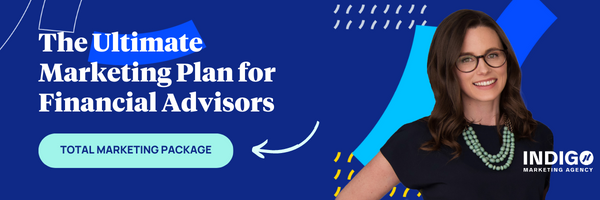How to Craft the Perfect Financial Advisor Marketing Budget

A Step-by-Step Guide for Financial Advisors
If you’re a financial advisor wondering, “How much should I really spend on marketing?”—you’re not alone. We get this question all the time from advisors we work with at every career stage.
While we don’t have a one-size-fits-all answer, we do know that a carefully crafted budget can make the difference between a strategic and effective marketing plan and one that lacks direction and impact.
If you’re a financial advisor asking yourself how to budget for marketing, read on for a step-by-step budget guide that drives real results.
Step #1: Understand Your Marketing Goals
Before you start allocating funds, the first step is to clearly define your marketing objectives. Common objectives include:
- Increasing brand awareness
- Generating leads
- Converting prospects into clients
- Retaining existing clients
Understanding your goals will help you prioritize spending, measure the results of your marketing efforts, and make adjustments as needed.
For instance, growth-focused firms should generally allocate more funds to marketing than firms that are well-established or those that are prioritizing client retention.
Identifying goals also helps you determine which marketing channels to utilize. A growing firm might focus on social media and paid advertising, while a firm with longevity may focus on email marketing and hosting events for existing clients.
Step #2: Analyze Your Current Financial Situation
Next, you’ll want to review your business financials to determine how much you can realistically spend on marketing. This involves analyzing your revenue, expenses, and profit margins. It’s important to invest in marketing, but it’s equally important to ensure your spending aligns with the overall financial health of your business. Once you understand your overall financial picture, you can get to work building your ideal marketing budget.
Step #3: Determine Your Test Budget
It’s never a good idea to blindly allocate funds toward financial advisor marketing. Instead, we recommend determining a test budget. This way, you can actively monitor the amount you spend and the return on your marketing investment before solidifying your target budget amount.
Survey data from Broadridge shows that advisors spend an average of $15,908 per year on marketing with the median marketing spend at $6,250.
A general guideline is to allocate approximately 1-10% of revenue on marketing, depending on your firm size, specific business goals, growth stage, and market dynamics.
- A well-established firm with steady revenue might allocate 7-10% of their revenue.
- Firms in growth mode looking to expand their client base quickly might invest 10-15% or more.
- On average, advisory teams spend $23,222 on marketing per year, while solo advisors spend $8,985.
Remember that even if you’re part of a larger firm or focused on growth, spending more does not necessarily mean you are spending well. The next steps in this guide help to ensure you’re making the most of your marketing budget.
Step #4: Allocate Funds Across Channels
Once you’ve determined your test budget, the next step is to allocate your funds across multiple marketing channels. A balanced approach typically involves a mix of:
- Digital Marketing: This includes SEO, pay-per-click advertising, social media advertising, and email marketing. Since digital channels are crucial for reaching a broad audience and generating leads, allocate the bulk of your budget here (about 50-60%).
- Content Marketing: Posting valuable content such as blogs, videos, and whitepapers is a great way to establish your authority and build trust. Around 25-30% of the budget should go here.
- Client Events and Webinars: Hosting events and webinars can foster relationships, demonstrate expertise, and retain existing clients—reserve 10-15% of the budget for these activities.
- Traditional Marketing: Depending on your ideal client, direct mail or print ads can still be effective. Allocate 10-15% here, but this can vary based on your audience’s preferences.
- Tools and Technology: Investing in CRM systems, marketing automation, and analytics tools is essential for tracking performance and improving ROI. Allocate 5-10% of your budget for these tools.
Step #5: Monitor and Adjust Your Budget
Marketing should not be a set-it-and-forget-it task, and neither should your budget. It’s best practice to regularly monitor the performance of your marketing activities and your total spending, then compare them against your goals. Use analytics tools to track key metrics, gather data-driven insights, and continuously adjust your test budget until you’ve found the right fit for you.
If your test budget and marketing allocations are successful, then you can maintain your strategy going forward. If your ROI is lower than expected, then you can play around with decreasing the budget or reallocating the funds to different marketing channels.
Step #6: Learn from Top Advisors
Just as you stay up to date on continuing education and the latest financial trends, financial advisors should also keep up with the latest marketing trends.
Advisors who work with Indigo know that we do the hard marketing work for you. We leverage insights from top-performing advisors to bring you the latest information on what’s working and what’s not for financial advisor marketing.
Here’s what the best in the business are doing:
- Data-Driven Decisions: Successful advisors use data analytics to guide their marketing efforts, ensuring each dollar spent is intentional and cost-effective.
- Personalized Client Experience: They invest in personalized marketing, rather than canned content, to build stronger client relationships and loyalty.
- Consistent Branding: Top advisors maintain a consistent and professional brand presence across all marketing channels, reinforcing their credibility and expertise.
Why Choose Us?
Even the best advisors find it challenging to develop, deploy, and monitor their marketing while also running a successful financial advisory business. Your time is limited, and we think it’s better spent doing what you do best: providing outstanding service to your clients and helping them lead more fulfilling lives.
If you’re tired of uncertainty and inconsistent marketing results, we’re here to help. At Indigo Marketing Agency, we analyze your practice’s strengths and opportunities to create a customized marketing plan that aligns with your specific goals. We also analyze past campaigns and industry trends to create high-ROI marketing plans and ensure your budget is spent wisely.
The best part?
Our Total Marketing Package includes three tiers of service, which means you have access to done-for-you marketing no matter your price point. And for those advisors looking for more of a DIY approach, the Indigo Advisor Club is a plug-and-play marketing toolkit at a bargain price.
Don’t sacrifice high-quality marketing for the sake of your budget. To learn more about our cost-effective custom content solutions, contact us to schedule a free strategy session today!

Schedule Your Free Marketing Strategy Call Today
Check Out Our Related Video Content
Whether you’re a beginner or looking to improve your existing video marketing efforts, this webinar is designed to provide actionable insights and practical tips to make your videos a success.
At Indigo Marketing Agency, we help financial advisors embrace the evolving marketing landscape by utilizing custom video content. Read on for three reasons why you should incorporate video into your marketing strategy and how the Indigo team can help.
Connecting with your clients is of the utmost importance. But it can be really challenging in today’s digital age with all the noise. How are you supposed to stand out from the crowd?
FAQs
Understanding your marketing goals is crucial because it helps prioritize spending, measure the results of your efforts, and make necessary adjustments. Clearly defined objectives, such as increasing brand awareness, generating leads, or retaining clients, guide the allocation of funds to the most effective channels and strategies, ensuring a targeted and impactful marketing plan.
Financial advisors can determine their marketing spend by analyzing their business financials, including revenue, expenses, and profit margins. A general guideline is to allocate 1-10% of revenue on marketing, depending on the firm’s size, goals, growth stage, and market dynamics. Conducting a test budget helps monitor spending and ROI before solidifying the target budget amount.
Key marketing channels for financial advisors include digital marketing (SEO, PPC, social media, email marketing), content marketing (blogs, videos, whitepapers), client events and webinars, traditional marketing (direct mail, print ads), and tools and technology (CRM systems, marketing automation, analytics tools). A balanced approach typically involves allocating 50-60% of the budget to digital marketing, 25-30% to content marketing, 10-15% to events and webinars, 10-15% to traditional marketing, and 5-10% to tools and technology.
Financial advisors can monitor and adjust their marketing budget by regularly tracking the performance of their marketing activities and spending. Using analytics tools to measure key metrics, gathering data-driven insights, and comparing results against goals help identify what’s working and what’s not. Advisors should continuously adjust their budget allocations based on these insights to optimize ROI and marketing effectiveness.
Top-performing financial advisors use data-driven decisions to guide their marketing efforts, ensuring each dollar spent is intentional and cost-effective. They invest in personalized marketing to build stronger client relationships and loyalty, and maintain a consistent and professional brand presence across all channels. These strategies help maximize the impact of their marketing budget and achieve better results.




































